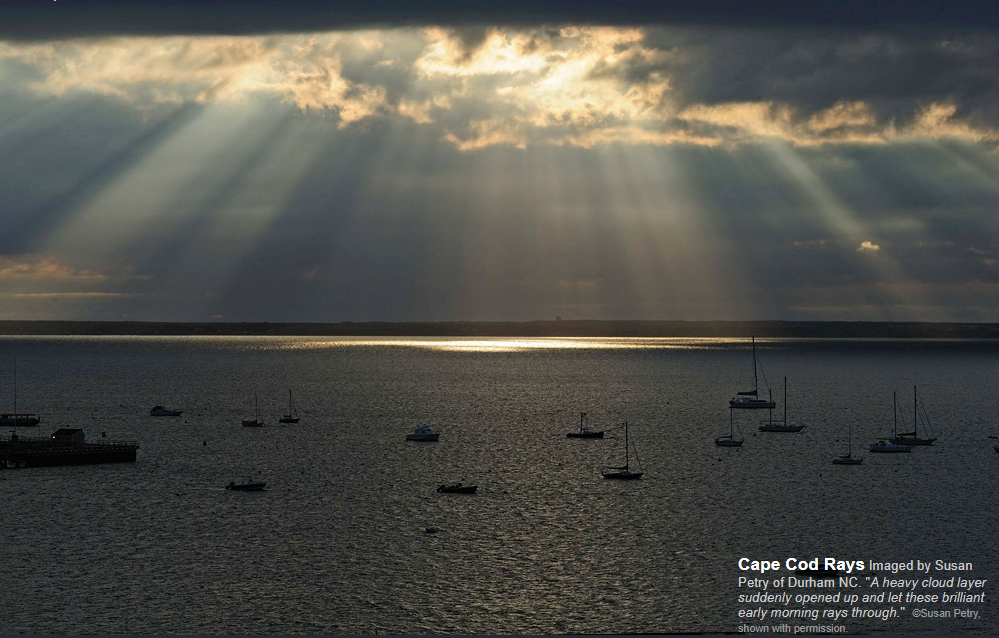OPOD - Cape Cod Rays
OPOD - Cape Cod Rays: A Spectacular Display of Nature's Light Show
Have you ever witnessed a breathtaking display of parallel rays of light descending from the sky? This extraordinary phenomenon, known as Cape Cod Rays, is a stunning example of atmospheric optics. Captured by Susan Petry of Durham, NC, in a moment of serendipity, these brilliant rays illuminated the early morning sky. Let's delve into the captivating world of Cape Cod Rays and explore the fascinating science behind this natural spectacle.
When observing Cape Cod Rays, it's essential to imagine them as parallel shafts of light. These radiant beams cascade from the heavens, seemingly converging towards the viewer. Next time you encounter this awe-inspiring phenomenon, try half-closing your eyes and envisioning the rays as they truly are - majestic pillars of light piercing through the atmosphere. By embracing their three-dimensional nature, you can truly appreciate the grandeur of this optical spectacle.
The formation of Cape Cod Rays is intricately linked to the interplay between sunlight and atmospheric particles. As sunlight passes through the atmosphere, it encounters tiny particles such as dust, water droplets, or ice crystals. These particles act as scattering agents, causing the light to deviate from its original path. When the conditions are just right, a captivating pattern emerges, resulting in the formation of parallel rays.
One might wonder how these rays appear parallel when they originate from a single light source - the Sun. The secret lies in perspective. Just as train tracks seem to converge in the distance, Cape Cod Rays exhibit a similar effect. The rays appear parallel due to our vantage point on Earth. However, if we were to view them from above, their convergence would become apparent. This optical illusion adds an extra layer of intrigue to an already mesmerizing phenomenon.
The intensity and clarity of Cape Cod Rays can vary depending on several factors. The presence of clouds plays a crucial role, as they act as natural filters for the sunlight. When a heavy cloud layer momentarily parts, it allows a surge of radiant beams to break through, casting an ethereal glow upon the landscape. The angle at which the rays intersect with the Earth's surface also contributes to their visibility. The lower the angle, the longer the rays appear, enhancing their dramatic effect.
Cape Cod Rays are not limited to a specific geographical location. However, their name originates from the beautiful Cape Cod region in Massachusetts, renowned for its picturesque landscapes and coastal charm. This coastal setting provides an ideal backdrop for capturing the interplay between light and atmosphere, making Cape Cod a popular destination for photographers and nature enthusiasts alike.
It is worth noting that the article you are currently reading has been automatically converted from the original website. Therefore, there may be some discrepancies or formatting issues. If you would like to view the original article, you can find it here.
In conclusion, Cape Cod Rays are a breathtaking manifestation of nature's artistry. As parallel shafts of light pierce through the atmosphere, they create a mesmerizing spectacle that captivates our imagination. Whether witnessed on Cape Cod or elsewhere in the world, these radiant beams remind us of the beauty and complexity that surround us. So, next time you find yourself under an open sky, keep an eye out for these enchanting rays and allow yourself to be swept away by their splendor.

Cape Cod Rays Imaged by Susan Petry of Durham NC. "A heavy cloud layer suddenly opened up and let these brilliant early morning rays through." ©Susan Petry, shown with permission.
The rays are all parallel and slanting down towards the camera. When next you see them half close your eyes and imagine them for what they are - parallel shafts of light - with luck their 3D nature will click.
Note: this article has been automatically converted from the old site and may not appear as intended. You can find the original article here.
Reference Atmospheric Optics
If you use any of the definitions, information, or data presented on Atmospheric Optics, please copy the link or reference below to properly credit us as the reference source. Thank you!
-
<a href="https://atoptics.co.uk/blog/opod-cape-cod-rays/">OPOD - Cape Cod Rays</a>
-
"OPOD - Cape Cod Rays". Atmospheric Optics. Accessed on November 26, 2024. https://atoptics.co.uk/blog/opod-cape-cod-rays/.
-
"OPOD - Cape Cod Rays". Atmospheric Optics, https://atoptics.co.uk/blog/opod-cape-cod-rays/. Accessed 26 November, 2024
-
OPOD - Cape Cod Rays. Atmospheric Optics. Retrieved from https://atoptics.co.uk/blog/opod-cape-cod-rays/.